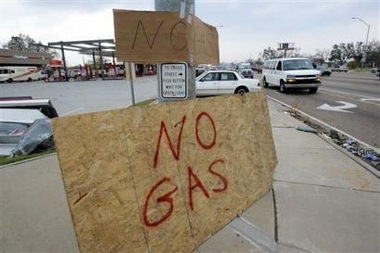Driving as a way of life
 Even with 'no gas' signs posted in Gulfport, Miss., Thursday, Sept. 1, 2005, lines formed outside any gas station that had people working on the pumps. Hurricane Katrina demolished most of the gas stations along the Gulf Coast, and knocked out the power stations needed to run those that were operational. (AP Photo/Rogelio Solis)
Even with 'no gas' signs posted in Gulfport, Miss., Thursday, Sept. 1, 2005, lines formed outside any gas station that had people working on the pumps. Hurricane Katrina demolished most of the gas stations along the Gulf Coast, and knocked out the power stations needed to run those that were operational. (AP Photo/Rogelio Solis)Yesterday's Richmond Times-Dispatch had an article "Price of gas fails to slow drivers: For many people, not using the car is an unrealistic option," chronicling the driving-dependence of an out-county family with four cars, for the parents and the two children. It's impressive how profound is the disconnect in understanding the impact of land use patterns and oil consumption.
From the article:
Folks grumbling while filling up and hitting the road doesn't surprise Robert Thompson, Professor of Television and Popular Culture at the Newhouse School of Public Communications at Syracuse University. "The automobile is so intrinsically woven into the American lifestyle that so far, these [prices] are still low enough the marketplace will support them," said Thompson, who has taught a course on the culture of the American automobile.
How ingrained is the car culture in our psyches? "If you make a statue to represent America, I think in the end the statue would be of a car," Thompson said. Our vehicles represent freedom, mobility, personal space, and often reflects our status "like your house, which you can't move around like your car," he said.
Studies show we log more miles than ever. From 1980 to 2000, the population increased by 55 million, while the number of cars and light trucks jumped by 72 million. More homes with fewer people is part of the reason people are driving more, said Siim Soot, professor and director emeritus of the Urban Transportation Center at the University of Illinois at Chicago.
"Around the turn of the [previous] century, we had five people per household. By 2000, we had 2.5. That means if you had 100 people in 20 houses [around 1900], that was 20 cars. If you have 2.5 people in the 20 houses today, you have about 40 cars," Soot said."



0 Comments:
Post a Comment
<< Home